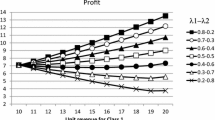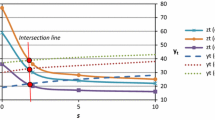Abstract
Capacity acquisition is often capital- and time-consuming for a business, and capacity investment is often partially or fully irreversible and difficult to change in the short term. Moreover, capacity determines the action space for service/production scheduling and lead-time quotation decisions. The quoted lead-time affects the customer’s perceived service quality. Thus, capacity acquisition level and lead-time quotation affect a firm’s revenue/profit directly or indirectly. In this paper, we investigate a joint optimization problem of capacity acquisition, delivery lead-time quotation and service-production scheduling with cyclical and lead-time-dependent demands. We first explore the structural properties of the optimal schedule given any capacity and lead-time. Then, the piecewise concave relationship between the delay penalty cost and the capacity acquisition level is found. Thereby, an efficient and effective polynomial time algorithm is provided to determine the optimal capacity acquisition level, delivery lead-time quotation and service/production schedule simultaneously. Furthermore, a capacity competition game among multiple firms is addressed. The numerical studies show that capacity equilibrium often exists and converges to a unique solution.







Similar content being viewed by others
References
Alfieri, A. (2007). Due date quoting and scheduling interaction in production lines. International Journal of Computer Integrated Manufacturing, 20(6), 579–587.
Allon, G., & Federgruen, A. (2008). Service competition with general queueing facilities. Operations Research, 56(4), 827–849.
Ata, B., & Olsen, T. L. (2009). Near-optimal dynamic lead-time quotation and scheduling under convex–concave customer delay costs. Operations Research, 57(3), 753–768.
Atamturk, A., & Hochbaum, D. S. (2001). Capacity acquisition, subcontracting, and lot sizing. Management Science, 47(8), 1081–1100.
Bechtold, S. E. (1981). Work force scheduling for arbitrary cyclic demands. Journal of Operations Management, 4(1), 205–214.
Besanko, D., & Besanko, D. (2010). Microeconomics. Hoboken: Wiley.
Boyaci, T., & Ray, S. (2003). Product differentiation and capacity cost interaction in time and price sensitive markets. Manufacturing & Service Operations Management, 5(1), 18–36.
Celik, S., & Maglaras, C. (2008). Dynamic pricing and lead-time quotation for a multiclass make-to-order queue. Management Science, 54(6), 1132–1146.
Chao, X., Chen, H., & Zheng, S. (2009). Dynamic capacity expansion for a service firm with capacity deterioration and supply uncertainty. Operations Research, 57(1), 82–93.
Duran, S., Gülü, A., Keskinocak, P., & Swann, J. L. (2006). Lead-time quotation and order acceptance when demand depends on service performance. Working paper, Georgia Institute of Technology, Atlanta.
Erkoc, M., Wu, S. D., & Gurnani, H. (2008). Delivery-date and capacity management in a decentralized internal market. Naval Research Logistics, 55(5), 390–405.
Graves, S. C., & Orlin, J. B. (1985). A minimum concave-cost dynamic network flow problem with an application to lot-sizing. Networks, 15, 59–71.
Green, L. V., Kolesar, P. J., & Soares, J. (2001). Improving the SIPP approach for staffing service systems that have cyclic demands. Operations Research, 49(4), 549–564.
Hale, N., & Downton, S. (1992). Managing a company in a cyclic market. BPICS Control, 29, 32.
Henry, R. J. (1990). Inventory replenishment policy with cyclic demands. Journal of Operational Research Society, 41(7), 639–643.
Hua, G., Wang, S., & Cheng, T. C. E. (2010). Price and lead-time decisions in dual-channel supply chains. European Journal of Operational Research, 205, 113–126.
Ignizio, J. P. (1995). Linear programming (pp. 361–401). New Jersey: Prentice Hall.
Ittig, P. T. (1994). Planning service capacity when demand is sensitive to delay. Decision Sciences, 25(4), 541–559.
Jansen, B., de Jone, J. J., Ross, C., & Terlaky, T. (1997). Sensitivity analysis in linear programming: Just be careful. European Journal of Operations Research, 101(1), 15–28.
Kaminsky, P., & Kaya, O. (2008). Inventory positioning, scheduling and lead-time quotation in supply chains. International Journal of Production Economics, 114(2), 276–293.
Keskinocak, P., Ravi, R., & Tayur, S. (2001). Scheduling and reliable lead-time quotation for orders with availability intervals and lead-time sensitive revenues. Management Science, 47(2), 264–279.
Klassen, K. J., & Rohleder, T. R. (2001). Combining operations and marketing to manage capacity and demand in services. The Service Industry’s Journal, 21(2), 1–30.
Li, H., & Meissner, J. (2011). Competition under capacitated dynamic lot sizing with capacity acquisition. International Journal of Production Economics, 131(2), 535–544.
Li, L., & Zhang, H. (2000). The multistage service facility startup and capacity model. Operations Research, 48(3), 490–497.
Liu, L., Parlar, M., & Zhu, S. X. (2007). Pricing and lead-time decisions in decentralized supply chains. Management Science, 53(5), 713–725.
Lucertinni, M., & Paletta, G. (1986). Optimal distribution strategies with cyclic demands. European Journal of Operations Research, 27, 324–331.
Özlük, O., Elimam, A. A., & Interaminense, E. (2010). Optimum service capacity and demand management with price incentives. European Journal of Operational Research, 204, 316–327.
Palaka, K., Erlebacher, S., & Kropp, D. H. (1998). Lead-time setting, capacity utilization, and pricing decisions under lead-time dependent demand. IIE Transactions, 30, 151–163.
Rao, U. S., Swaminathan, J. M., & Zhang, J. (2005). Demand and production management with uniform guaranteed lead-time. Production and Operations Management, 14(4), 400–412.
Ray, S., & Jewkes, E. M. (2004). Customer lead-time management when both demand and price are lead-time sensitive. European Journal of Operational Research, 153, 769–781.
Shang, W., & Liu, L. (2011). Promised delivery time and capacity games in time-based competition. Management Science, 57(3), 599–610.
Slotnick, S. A. (2011). Optimal and heuristic lead-time quotation for an integrated steel mill with a minimum batch size. European Journal of Operational Research, 210, 527–536.
So, K. C. (2000). Price and time competition for service delivery. Manufacturing & Service Operations Management, 2(4), 392–409.
Steiner, G., & Zhang, R. (2011). Minimizing the weighted number of tardy jobs with due date assignment and capacity-constrained deliveries. Annals of Operations Research, 2(4), 392–409.
Upasani, A., & Uzsoy, R. (2008). Incorporating manufacturing lead-times in joint production-marketing models: A review and some future directions. Annals of Operations Research, 191(1), 171–181.
Vives, X. (1990). Nash equalibrium with startegic complementarities. Journal of Mathematical Economics, 19(3), 305–321.
Van Mieghem, J. A. (2003). Capacity management, investment, and hedging: review and recent developments. Manufacturing & Service Operations Management, 5(4), 269–302.
Xiao, T. J., & Qi, X. T. (2012). A two-stage supply chain with demand sensitive to price, delivery time, and reliability of delivery. Annals of Operations Research, Published online.
Author information
Authors and Affiliations
Corresponding author
Appendices
Algorithm 1
Apart from the notations defined in Table 1, the following notations are also used in the algorithms.
-
X = \((x_{ij})_{T\times T}\) the service schedule matrix;
-
\(\bar{d}\)= average demand of the firm per period;
-
Q= the number of orders waiting to be processed in any period;
-
\(q_{t}\) = the queue length at the end of period t.

Algorithm 2

Algorithm 3
In order to facilitate the description of the algorithms, the following notations are applied.
-
\(TI_{2\times n}\) = the matrix to record the time intervals with positive queue length;
-
\(\ell _1\) = TI(k, 1), the first period in the \(k_{th}\) time interval;
-
\(\ell _2\) = TI(k, 2), the last period in the \(k_{th}\) time interval;
-
\(\varOmega _{5 \times T}\) = the matrix to describe the penalty cost function;
-
NTI = the start period of a new time interval;
-
KP= the intercept of penalty cost function P(L, C);
-
SP = the slope of penalty cost function P(L, C);
-
\(C_{BP}\) = capacity break points.

Rights and permissions
About this article
Cite this article
Li, H., Meissner, J. Capacity optimization and competition with cyclical and lead-time-dependent demands. Ann Oper Res 271, 737–763 (2018). https://doi.org/10.1007/s10479-018-2773-7
Published:
Issue Date:
DOI: https://doi.org/10.1007/s10479-018-2773-7




